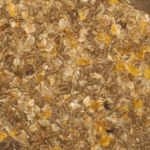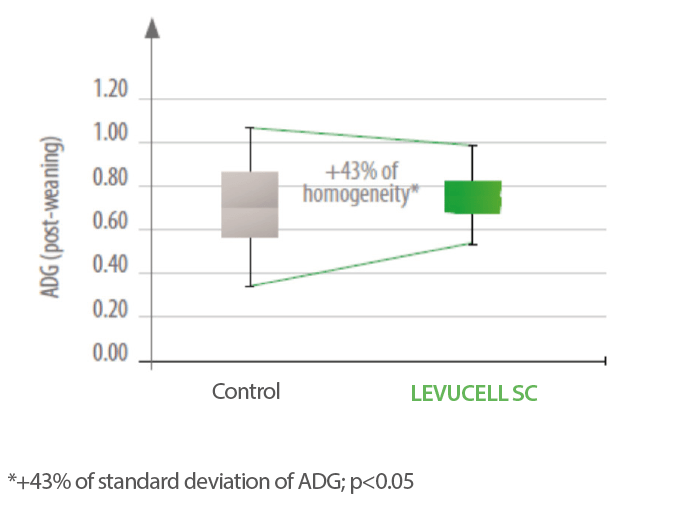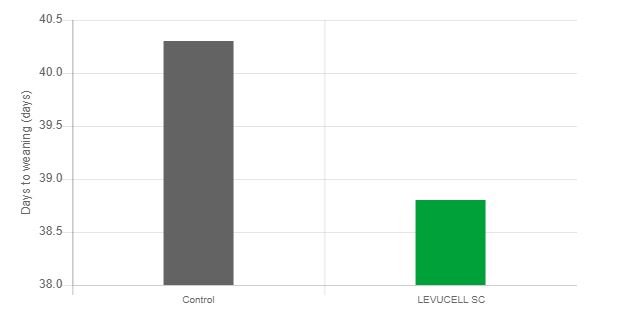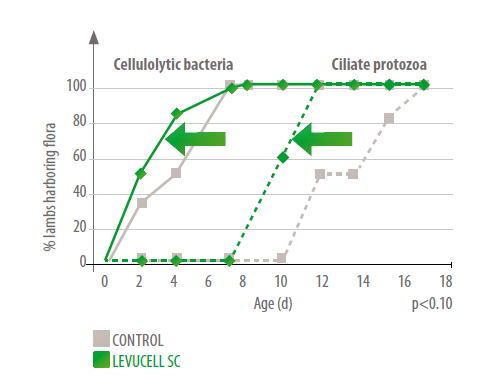Blog | Reading Time 5 minutes
Live yeast benefits young ruminants to secure future performance
It takes two years for a dairy calf to reach full its genetic potential in terms of dairy production, and three years to reach its full mature size. Poor growing and weaning management could result in impaired rumen development, reduced feed intake, and, therefore, lowered growth. The rumen-specific live yeast Saccharomyces cerevisiae CNCM I-1077 (LEVUCELL SC) is well documented for its ability to support rumen maturation and function in young animals. Many trials confirm the benefits of its supplementation in solid feeds for calves, showing greater starter intake, improved growth rate, and homogeneity. This results in earlier weaning and real return on investment for the producer.
Starter intake increased by 20%
 Starter feed intake can be a limiting factor for optimal growth. Multiple trials conducted with various feeding systems consistently indicate a positive effect of S. cerevisiae CNCM I-1077 supplementation on starter feed intake: +20% pre-weaning; +8% post-weaning (average of nine research trial results conducted in calves at different stages; Lallemand Animal Nutrition, internal results, 2005-2017).
Starter feed intake can be a limiting factor for optimal growth. Multiple trials conducted with various feeding systems consistently indicate a positive effect of S. cerevisiae CNCM I-1077 supplementation on starter feed intake: +20% pre-weaning; +8% post-weaning (average of nine research trial results conducted in calves at different stages; Lallemand Animal Nutrition, internal results, 2005-2017).
Such an effect can be considered as an indicator of improved rumen function.
Growth performance: +10%
In the same trials, higher starter intake is translated into improved growth performance: between 30 to 200g of extra daily weight gain were recorded, which is equivalent to an average increase of 120g/day, or 10%.
Also, the calves fed LEVUCELL SC gained more uniformly as a group, when compared to controls (figure 1).

Figure 1: Effect of LEVUCELL SC on growth homogeneity in calves receiving diet supplementation. Trial conducted on 120 Holstein calves in total, between nine and 65 days of age, initial bodyweight=43kg. IRTA, Spain, 2013).
Save days to weaning
As a result of the improved growth rate, weaning weight can be attained earlier. In a CRF USA trial, for example, the weaning period is reduced by 1.5 days on average (figure 2).
Effect of LEVUCELL SC diet supplementation on weaning duration: weaning occurs 1.5 days earlier due to increased body weight gain (Trial conducted over 56 days on 72 pre-weaning bull calves with initial body weight 37.1 kg, USA 2009).
Financial outcome
Improved growth using S. cerevisiae CNCM I-1077 is translated into a 4:1 ROI if considering the short-term effect (growth). When considering projection from large scale calf/heifer observation (Bach et Ahedo et 2008), such improvement can be extrapolated into long term benefits too (figure 3).

Figure 3: Example of ROI calculation when using S. cerevisiae CNCM I-1077 in calves (Lallemand/IRTA internal results, 2013).
How does it work?
S. cerevisiae CNCM I-1077 is a highly documented active dry yeast strain for ruminant feeding. Hundreds of scientific publications, including many peer-reviewed papers, describe its modes of action. Three major mechanisms can help explain the benefits observed in calves.
1. Enhanced rumen maturation
When fed S. cerevisiae CNCM I-1077, young ruminants have shown an accelerated rate of establishment of two major microbiota populations for fiber degradation: the cellulolytic bacteria and ciliate protozoa (figure 4) (Chaucheyras-Durand and Fonty, 2002). Overall, the maturation of the rumen microbial ecosystem appears more rapid than without the live yeast, in particular, as protozoa are necessary to complete the full colonization sequence.

Figure 4: Effect of S. cerevisiae CNCM I-1077 on microflora establishment in young ruminants (Chaucheyras-Durand and Fonty, 2002).
In addition, rumen wall papillae development is improved with longer papillae (p=0.06) (Bittar and Ferreria, 2007). As a result, the rumen absorption surface is increased, which favors nutrient uptake and contributes to better performance.
2) Optimized rumen pH
One of the key effects of S. cerevisiae CNCM I-1077 is the stabilization of rumen pH in the rumen environment. For instance, a trial conducted in Spain (Terré et al., 2015) on 9 days old Holstein calves, showed that rumen pH is significantly improved during the weaning transition.
Another study using DNA sequencing technology enabled to show that the populations of lactate-utilizing bacteria (Megasphaera and Selenomonas) were significantly increased in calves at weaning when feeding the live yeast (Lallemand Animal Nutrition, internal data, Spain 2017).
3) Improved fibrolytic potential
The 2015 IRTA trial (Terré et al., 2015) also showed enriched cellulolytic bacteria populations in the rumen of the S. cerevisiae CNCM I-1077-supplemented group with a greater abundance of Ruminococcus albus, an important cellulolytic bacterial species.
The activity of fibrolytic enzymes is also improved. This has potentially positive effects on fiber and dry matter degradation.
Conclusion
During the first months of life and around weaning, the digestive system of young ruminants develops, and many challenges can alter this development — with potential long-term consequences. The rumen microbiota balance, which is important to ensure optimal performance and welfare, is closely linked to calf management. Commercial and research trials confirm the benefits of live yeast supplementation in a calf’s diet, from birth to weaning: greater starter intake, improved growth rate, and homogeneity, resulting in earlier weaning and real ROI for the producer.
The calf rumen is better prepared and will ensure optimal dairy performance later in life.
S.cerevisiae CNCM I-1077 can be supplemented to calves before weaning in the solid feed. For more information visit the Levucell SC product page.
Published Nov 12, 2020 | Updated Jun 7, 2023
Related articles
Need specific information?
Talk to an expert